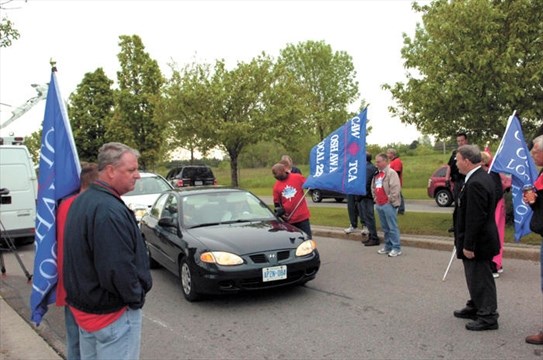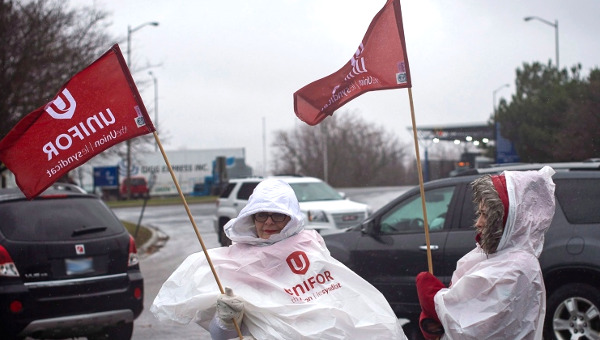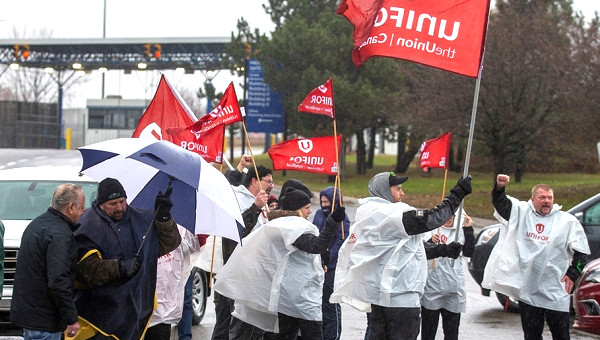The Oshawa Plant Closing
In the wake of GM’s shocking announcement of its plan to close the Oshawa Truck Plant – just two weeks after the end of bargaining – CAW Local 222 organized a blockade of the corporation’s Canadian headquarters. For 12 days the union local challenged the American-based auto giant to rescind its decision to close its award winning Truck Plant.
 In bargaining, GM promised to continue production at the plant at least until 2011 in exchange for major concessions from the union. The blockade is now down and the workers are left with both a soon to be closed plant as well as the concessions, although the local leadership has let it be known that it will challenge the latter.
In bargaining, GM promised to continue production at the plant at least until 2011 in exchange for major concessions from the union. The blockade is now down and the workers are left with both a soon to be closed plant as well as the concessions, although the local leadership has let it be known that it will challenge the latter.
What happened? Could the union have built a more sustained movement to challenge the plant closing? Would it have made a difference? What can the union do now? Are there any lessons we can learn from this experience that can help build for the future?
Concessions Bargaining and the “Double Cross”
A mere two weeks before the announcement the CAW and GM finished bargaining a Master and Local Agreement loaded with concessions and negotiated four months before the usual September expiration date. The rationale used by CAW President Buzz Hargrove was that early bargaining would avoid having to deal with the consequences of a further deterioration in the auto market in the fall that would have made the union more vulnerable to demands for a UAW-style, two-tier agreement. The approach involved promises of new product investment in exchange for “cost savings” – another word for concessions. Hargrove told the press that the agreement would save “GM 300 million dollars over the next three years.”
The strategy backfired when GM reneged; claiming that market realities had changed, necessitating a further round of plant closings and product consolidation and cancellations. The result was the announcement of the impending closure of the Oshawa Truck Plant. It is to be closed at the end of 2009, while production of pick-up trucks will be continued at plants in Mexico and the USA.
Workers at Local 222 were outraged and the local union leadership looked for a strategy to challenge the announced closing. Unable to pull-off a full-scale occupation, they blockaded GM’s head offices, demanding that the closing be rescinded. CAW President Hargrove – clearly embarrassed by GM’s double cross – criticized GM publicly for violating its commitments in the collective agreements and insisted that they rescind the closing.
The union demanded and got a meeting with GM’s top brass in Detroit, but the corporation refused to budge.
After the meeting, the local continued the blockade and organized a motorcade around the Oshawa complex, briefly stopping production. They later organized a mass rally of over 5,000 people at the Truck Plant parking lot. GM, in turn, asked for an injunction to end the blockade and charged the local union officers with damages. On June 12, an Ontario Superior Court Judge issued an injunction to end the blockade, but conceded that GM had engaged in “almost deceitful conduct” in collective bargaining. The issue of punitive damages remains outstanding.
GM tried to diffuse the situation by offering to build 4000 hybrid trucks at the Truck plant, but the numbers wouldn’t be enough to keep the facility open for more than two weeks. They also dangled the promise of more car models in the car plant, to go along with the redesigned Camaro, including the Malibu and a new Cadillac model. Neither of these “solutions” would make up for the loss of the 2600 jobs at the Truck Plant.
Where’s the Surprise?
The CAW leadership shouldn’t have been surprised by GM’s double cross: the corporation already did this once before in 2005, when, soon after bargaining, they demanded a series of takeaways that were supposed to be necessary to keep the car plant open and bring new investment there. The result was the infamous “shelf agreement” that gave up relief time, outsourced 400 maintenance jobs and didn’t result in immediate investment and jobs. This started a round of similar agreements in other companies and began the process of ratchetting-down working conditions and later wages and benefits across the auto industry, in exchange for promises of new investments and jobs. It taught the auto employers that, contrary to the union’s public bravado, the CAW would willingly trade even more concessions in the future. After all, if it worked in 2005, why wouldn’t it work now?
The plans to close the truck plant demonstrated the bankruptcy of this strategy of trading concessions for promises of jobs and new investment.
Creating a Sustained Movement?
The struggle never really developed beyond the largely symbolic blockade, yet it had the potential to do so. In order to pressure GM to change its decision, the union had to dramatically raise the ante of its tactics, moving on to an occupation of the plants, in particular the Car Plant which is producing cars that are still selling; and mount a larger, community-based political campaign against Free Trade, corporate power and for environmentally-friendly vehicles and components.
The blockade was never built into a more radical strategy of plant occupation. This was certainly possible, but there were a number of factors which made it very difficult to do so. It wasn’t because of opposition from the local leadership. While the latter was divided, there were those who looked to increase the pressure. The causes are much deeper and reflect the difficult objective conditions, but also the strategy the National union leadership has pursued over the past five years or so.
Since the early part of the decade, the union literally gave up challenging the Big 3 employers, especially GM:
- The union’s political campaigns to pressure politicians to support a strategy defending the auto industry were flawed. In practise, the campaigns featured calls for subsidies to the Detroit-based auto employers to literally bribe them into investing in Ontario – dropping traditional union calls for reinstituting content rules, forcing auto assemblers to build in Ontario in return for duty-free access to the Canadian market. Later, they began to feature calls on the Federal government to somehow force Asian and European countries to open up their markets to Big three goods assembled in Canada. The campaigns involved some mobilization, but were devoid of criticisms of the employers, and were tied to an informal alliance with Liberal politicians who had promised to support subsidies.
- Oshawa workers experienced various rounds of concessionary bargaining. They saw the National Union adopt the Magna Framework, which gave up the right to strike and an independent workplace in-plant committee, in exchange for the right to unionize. The concessionary Big 3 Auto Master Agreement, bargained earlier in May, which froze wages and 2 COLA payments, gave up a week of vacation, brought in large drug co-pays and provided for a 70% new hire rate, growing into full pay by the end of the three year agreement. In Oshawa, another series of local concessions arrived including cuts to relief time, provisions for short periods of mandatory overtime, supplementary workers, an agreement to bring in outsourced work at two-tier rates and possible non-union conditions and changes to the production standards language that gave the employer increased leverage on the shop floor.
The Master agreement was celebrated as a victory against two-tier wage demands from the company, but the give-backs match the U.S. concessions of 1984 that led to the secession of the Canadian region from the UAW at that time, (see Bullet #105, May 6, 2008, The CAW and Panic Bargaining: Early Opening at the Big Three, by Sam Gindin).
The contract was bargained without any input from the rank and file, and the ratification vote was held on the first long weekend of the summer season at GM, without any opportunity by workers to read over or discuss its provisions. This “Panic bargaining” was justified by what Buzz Hargrove called “the perfect storm” in the auto industry. In other words, it built on a wave of panic and fear by the membership, carefully cultivated and reinforced by both the union and the employer.
- When a union changes from mobilizing, organizing and challenging employers to identifying with their goals and interests and seeks to convince members of the need for concessions, rather than struggle against them, it transforms the entire nature of the organization. It changes leadership and affects the overall mood of the rank and file. Members have to be reminded of the limits of what they can do, rather than their potential to raise the level of collective resistance. They have to be discouraged from questioning and fighting back. Resignation and acceptance of the status quo – values encouraged by employers and the dominant interests in our society – are somehow taken as good things that don’t rock the boat. “Troublemakers” are seen as potential problems. Over time, this has had an extremely corrosive effect on both lower levels of leadership and the membership, even though it creates the appearance of a union that is in tune with the everyday realities of the rank and file.
All of this had the effect of undermining worker confidence and militancy.
With the coming of this new crisis, local leaders and activists had a difficult time figuring out how to change gears. The lack of experience in struggle by the membership in the face of all of this reinforced the tendency to seek individual solutions, such as looking forward to retirement, seeking buyouts, transfers and bonuses. All of this made it all the more difficult for the local leadership – itself relatively new and inexperienced with such challenges – to develop a strategy to challenge the closing.
Given the context, the organization of the blockade, the motorcade and the local rallies were important first steps. But moving on from these first steps required a much more sustained effort to challenge the corporation directly and create a larger and wider political campaign.
What might have been done to build such a movement?
The local could have developed a campaign to convince the members to get involved in activities to reverse the announced closing. They could have drawn on the CAW National Union’s education and research departments to develop materials explaining why the plant is viable and why Oshawa workers and the entire community has a right to keep that plant open.
In order to build the confidence and capacity of both the membership and leadership to participate and lead this campaign they could have organized the in-plant union reps to meet with their constituents to explain the necessity and possibility of mobilizing against the company. This could have built into larger union meetings to discuss strategy – like the Steelworkers local at Stelco did in the fight against concessions two years ago in Hamilton.
Other building steps were possible as well, such as selected work slowdowns, and other inside pressure tactics, used by other activists in similar situations. Eventually, an activist core could have been mobilized to occupy the truck or car plant.
Could the membership have learned from its experience in struggle and education, in such a way as to agree to participate in such tactics? From the experience at the blockade, protest caravan and rally, it was clear that a growing number of workers were finally convinced that struggle was possible, and it was spreading beyond the usual group of union activists and officials – but it was never tied to systematic efforts to expand the level of participation. That could have been done – and can be done in future struggles.
Building a Bigger Campaign – Raising Bigger Questions
Any possibility of pushing GM back also required a bigger political campaign to be waged by the union, targeting not only GM’s right to close the facility and move production to Mexico and the U.S., but raising demands for production of environmentally responsible vehicles, and forcing them to produce vehicles and components that will dramatically reduce greenhouse gas emissions. All of this required raising the issue of Free Trade once again, in a very concrete way.
This might have involved a strategy to co-ordinate CAW Locals, across Southern Ontario along with community coalitions and the rest of the labour movement. This is not impossible: In 1996, the CAW succeeded in winning over the hearts and minds of working people throughout the Province, when it was forced to strike GM over outsourcing and work ownership. At that time, the union identified its struggle with the demand of all working people for secure jobs, in an era when employers were outsourcing work to cheaper venues. If the union could succeed then – it could succeed now.
It wasn’t difficult to see how, even in this age of high neoliberalism, when the working class is so divided between well-paid workers and those close to the minimum wage and so many are convinced that the demands of unionized workers are a barrier to economic well-being, the struggle against GM was striking a chord in the common experience of working people across the community. This could and should have been built upon.
The struggle could have contributed to a new upsurge against Free Trade: after all, opposition to neoliberal globalization involves the need to politically limit the freedom of capital to move where and when it wants, and rests on the demand to democratically control investment for the needs of working people. As soon as the struggle against the planned closure broke out, the union began changing its public statements, once again calling for a new auto pact, forcing auto companies to produce the value of what they sell here. Why couldn’t this have been expanded into a call for an end to Free Trade Agreements, building unity with all of those affected by trade liberalization?
As well, the social and environmental costs of the continued reliance on expensive and polluting fossil fuels are so obviously clear – that even the auto companies realize they have to make some changes to their product offering. This presents an important opportunity for the union movement to emphasize the link between the environment and jobs, and its absolute commitment to defend both. This, too, requires political intervention to force producers to both radically alter what they produce, but also methods of producing them.
Given the difficult set of challenges here, none of this would have been possible – neither a plant occupation, nor a political campaign – without the strong support from the National Union. This certainly was not forthcoming. There was no effort to expand this struggle; no plan for concretely creating a real movement against Free Trade out of this; no consultation with other unions on how to build something; and, a very weak and compromised record of refusing to challenge the employers or governments on their environmental responsibilities.
Would it have forced GM to find another product for the Truck Plant? Who knows? Such a strategy would have galvanized a collective political voice, letting GM know that it cannot abdicate its responsibility to the community and the workforce that has sustained and subsidized it for over 3/4 of a century. It would have taught GM – and other corporations, U.S.-owned or not – that Canadian working people and their unions will not allow them to take away their livelihoods and close what is effectively community property without a paying a stiff price.
While there are certainly no guarantees, it certainly would make them think twice in the future, and in the process, helped to rebuild the capacity of the union to organize, mobilize and inspire its members.
What can the union do now?
At the very least, the union can argue – as a number of leaders from Local 222 have done – that the concessions at the local and Master level should be considered null and void, given GM’s brazen double cross. That would mean that the original three-year agreement would remain in force until September, when normal bargaining would begin. Would this affect agreements bargained at Ford and Chrysler? Perhaps. It would force the union’s institutions to grapple with the mess created by relying on the “concessions for investment” strategy. Maybe it would mean that GM would retain the old agreement and go it alone in September. (Ford Oakville workers recorded an historic rejection of the concessionary agreement and could perhaps do the same thing. See Sam Gindin’s Bullet #105).
Inspiration and Leadership
In the face of overwhelming odds and constraints, the leadership of Local 222 succeeded in inspiring and mobilizing a number of activists and rank and file CAW members. Attending the rallies and talking with the blockaders, you couldn’t help but be impressed by the changing attitudes of the members who participated. Workers in Local 222 have been watching GM’s actions very closely and have a very deep sense of both the weaknesses, but also the real strengths of their union. They want their union to show leadership and provide some collective alternatives to simply taking buyouts, waiting for retirement or seeking transfers to more secure jobs. They also have a lot of respect for their local leaders.
Many of these local leaders have matured politically through this experience. Learning how to mobilize and organize in the current context is not easy, but these leaders seem to have taken important steps forward. One can only hope that the inability to prevent the closing doesn’t lead to a new period of demoralization and acceptance. The local can still pressure the corporation by refusing to apply the local concessions bargained in the last agreement and by defending against employer attempts to intensify workloads and discipline workers for exercising their rights in the workplace.
Hopefully, the lesson has been learned by the leadership and rank and file, that concessions won’t protect jobs. As we have seen in the UAW and now here, once employers get the taste of concessions, they keep coming back for more. Those who are looking to enjoy their pensions should keep in mind that in the future, there is nothing to stop the company from looking for concessions there, as well. Nothing is locked in forever – without fighting back, there is no stopping them.
The same can’t be said for the National Union leadership. During much of the struggle in Oshawa, the CAW was holding its National Collective Bargaining and Legislative Convention in Toronto. Aside from the fact that the horse was out of the barn on the collective bargaining front (the Big 3 contracts were signed already), the Convention wasn’t used to mobilize a larger campaign to challenge GM.
At the very least, they did pass emergency resolutions calling on the Federal Government to apply the provisions of the auto pact for GM to keep producing trucks at the Oshawa facility. Aside from this, it was bizarre and sad to see both the Convention and the glitzy Hargrove tribute dinner happening as a kind of counterpoint to the Oshawa struggle.
The union needs to sincerely assess the validity of the road that it has chosen in both collective bargaining and in political action. If the Oshawa Truck Plant closing forces a serious debate about this – with a new president taking office in September, and in the context of a possible election for Secretary-Treasurer – it would be an important step forward for the union. •





